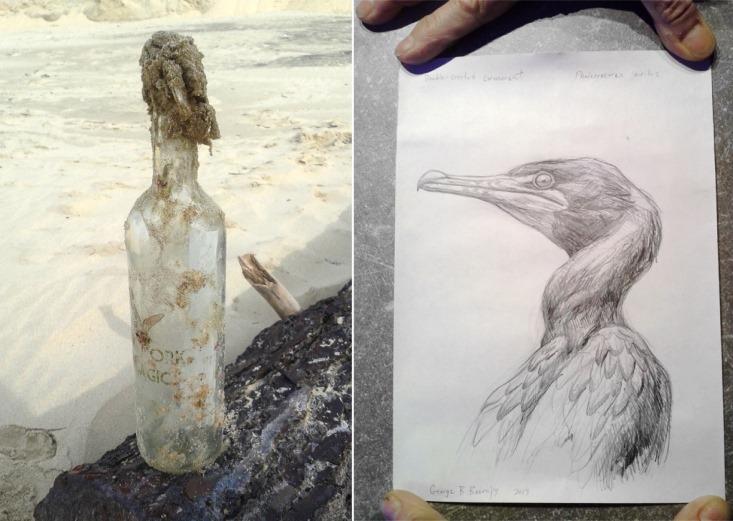Nearly three years ago, George Boorujy took a trip to Wolfe’s Pond Park, on the southeastern edge of Staten Island in New York City, and threw a bottle into the ocean.
On a cold, sunny day this February, artist Brigitte Barthelemy, her husband, and their schnauzer, Elton, went for a walk on a beach in Royan, France, some 3,600 miles as the tuna swims from where Boorujy watched his bottle float away. And there it was: barnacle-encrusted and seawater-clouded, but not yet so mucky as to obscure an inscription reading “New York Pelagic” and two tightly rolled cylinders of paper held within.
“We have found a treasure,” thought Barthelemy, and indeed they had.

Boorujy, an artist known for large-format, exquisitely detailed drawings of animals, started the project New York Pelagic in 2011 as a commentary on trash in our oceans and celebration of the birds who live there. Each of the 19 bottles he’s launched so far contains a note with his contact information and a pencil drawing of an ocean-dwelling bird—a sooty tern in Virginia Key, a Manx shearwater on Connecticut’s Sheffield Island, a Caspian tern in Miami—with Barthelemy’s bottle, containing a double-crested cormorant, having traveled farthest of them all.
Its recovery would seem to beggar probability. Then again, migration itself is miraculously improbable, too: Common terns like the one depicted in a bottle that Boorujy threw into Brooklyn’s Four Sparrow Marsh in 2011, as yet unfound, may breed in the Arctic and winter on the southern tip of South America. Double-crested cormorants, not particularly known for their own migratory feats, still journey each year from the Great Plains to the Gulf of Mexico and back again.
They’re not known to cross the Atlantic, yet every so often one appears in Western Europe, thrown off-course by storms or perhaps simply by an adventurous spirit—what ornithologists call a vagrant. Barthelemy’s own cormorant was carried by the currents of the North Atlantic Gyre: The bottle likely rode the Gulf Stream north from Staten Island before catching the Azores Current from Newfoundland to Great Britain, where Rennell’s Current pulled it to southern France.1
Cormorants are often considered trash birds and are vilified by fishermen and even conservationists.
And there it was on that February morning, a bright, clear day following a storm that had deposited debris that left Barthelemy horrified: plastic bottles, pieces of boats, old clothing—the very sort of junk to which Boorujy hopes New York Pelagic will draw attention. (“Pelagic” describes animals that spend time in open water, far from the shore or seafloor.)
The North Atlantic, after all, has its own garbage patch—one not so well-known as the infamous Great Pacific garbage patch, but terrible nonetheless: a drifting zone of plastic hundreds of miles long and wide. New York Pelagic also brings our gaze to the seabirds themselves: a whole aviary that few people, even those who live near an ocean, can identify. The dozens of gull species reduced to a single catch-all name of “seagull,” the shearwaters and terns who register mostly as background elements on a trip to the shore, the cormorants whose underwater fish-catching acrobatics go largely unacknowledged.
If they somehow learn about New York Pelagic, double-crested cormorants may think that it’s about time they receive some positive attention from us humans. Cormorants are often considered trash birds and are vilified by fishermen and even conservationists. Their name inspired the adjective “cormorous,” now lost to common speech but once used to convey rapacious gluttony.
After being driven to near-total demise in the mid-20th century by the pesticide DDT, cormorant populations rebounded to the point where they’re now subjects of considerable controversy. In the Pacific Northwest they’re slaughtered for eating salmon; in the eastern U.S., a federal court recently ruled against the U.S. Fish and Wildlife Service’s policy of allowing up to 160,000 cormorants—10 percent of the entire North American population—to be shot on sight every year because they eat sportfish.
The visceral dislike that some people feel towards cormorants mystifies Boorujy. “We’re always imposing our own values and attitudes,” he says. “But aside from the Linnaean system, any sort of classification is very weird.”2
Recognizing seabirds, putting a name and a life history to the creatures affected by our thoughtlessness, stripping away the baggage we bring to our perception of them, is a step towards caring about them, says Boorujy.
“If you don’t know anything about the environment, it’s easy to not care about it, or to only think about it in abstract terms,” he says. “The more you know, the more you care.”
And that is the ultimate message in this bottle.
Footnotes
1. Many thanks to many thanks to oceanographer Donald Olson of the University of Miami for tracing the bottle’s likely path. Quite appropriately, these currents were first charted by bottle-tossing scientists and nautical enthusiasts. It was none other than Benjamin Franklin and his cousin Timothy Folger who originally mapped the Gulf Stream.
As it happens, the University of Miami is where the New Jersey–raised Boorujy attended college, studying marine biology before switching to art. Florida remains a conceptual lodestar for Boorujy; he describes it as “a limestone driftnet jutting out into the tropics,” and the region’s seething, ephemeral ecological and cultural mashup is the subject of several past and future pieces.
2. This sensibility is conveyed subtly in Boorujy’s drawings, which usually portray their subject from an unusual vantage: at eye level, or gazing down at the viewer, a shift in perspective that conveys a sense of immediacy and individuality often lost in classical natural history-style illustration.
Barthelemy’s cormorant looks back over his shoulder as if surprised by an observer on whom one beady eye is now fixed. He’s not just a representative example of Phalacrocorax auritus, but an individual.
Brandon Keim is a freelance journalist who writes about science, technology, and nature. His work has appeared in Wired, Aeon, Scientific American Mind, and other publications.




























